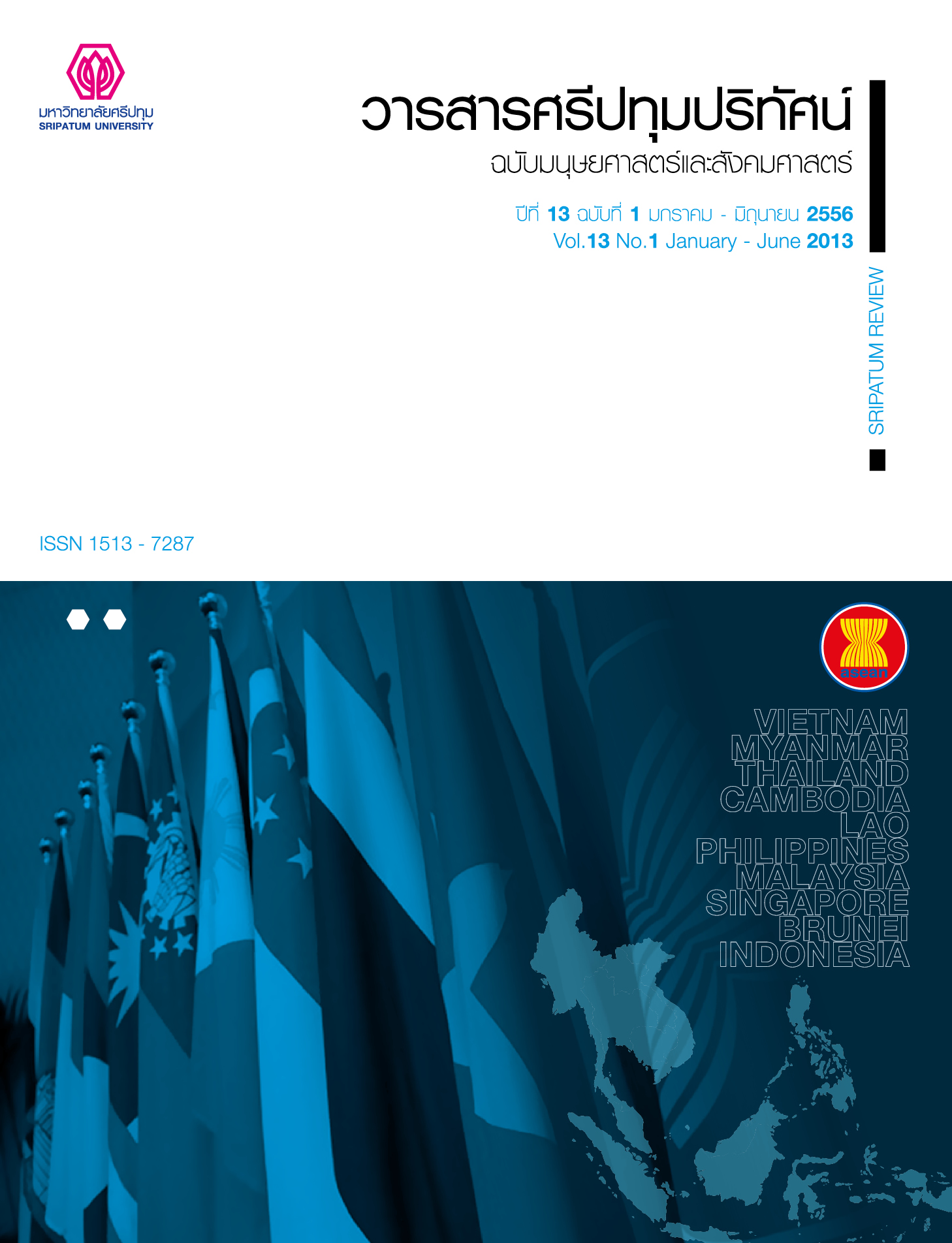A STUDY SATISFACTION WITH THE USE OF A LEARNER-CENTRED METHOD IN EFL CLASSROOM BY UNDERGRADUATE STUDENTS AT THAI-NICHI INSTITUTE OF TECHNOLOGY, BANGKOK
Main Article Content
Abstract
The purposes of this research were 1) to examine the satisfaction level of Thai undergraduate students with a learner-centred method in EFL classrooms in six areas: curriculum, teaching-learning process, instructional media, instructors, evaluation, and supporting resources, 2) to compare students’ effects of satisfaction with the use of a learner-centred method in EFL classroom on the six aspects according to students’ gender, age, academic years and majors, and 3) to elicit the students opinions and suggestions regarding the implementation of a learner-centred teaching/ learning in EFL classrooms.
The research sample consisted of 532 undergraduate students drawn from those studying at the Thai-Nichi Institute of Technology using a stratified random sampling technique. The instrument used for gathering the data was a five-point rating-scale questionnaire with open-ended questions at the end. The statistics used for analyzing the data were the frequency, percentage, mean, standard deviation, t-test, and F-test. Also, descriptive data were analyzed with content analysis.
The findings were as follows:
1.As a whole, the satisfaction of Thai undergraduate students with the learner-centred method was at the high level. When each area was considered, the satisfaction of students was at the high level with the following areas: curriculum, teaching-learning process, teaching materials, instructors, and evaluation; while their satisfaction with supporting resources was at the moderate level.
2.Students with different genders did not differ significantlyin their overall satisfaction with the learner- centred method in EFL classroom. They also did not differ significantly in their satisfaction with each area of the learner-centred method.
3. Students with different ages did not differ significantly in their overall satisfaction with the learner-centred method in EFL classroom. However, when each area of the method was considered, it was found that they differed significantly in the area of supporting resources, with the satisfaction of 18 years old female students being significantly different from that of 22 years old male students at the .05 level.
4. Students in different academic year levelsdidnot differ significantly in their overall satisfaction with the learner-centred method in EFL classroom. However, when each area of the method was considered, it was found that the satisfaction with the supporting resources area of first year students differed significantly from that of the fourthyear students at the .05 level.
5.Students with different majors did not differ significantly in their overall satisfaction with the learner-centredmethod in EFL classroom. However, when each area of the method was considered, significant differences in satisfaction were found in the supporting resources area, with that of students in the Japanese Business Administration Program being significantly different from that of students in the Production Engineering Program, and that of students in the Japanese Business Administration Program being significantly different from that of students in the Industrial Management Program.
6. The students provided the following suggestions: in the curriculum area, the developed curriculum should be relevant to the needs of the learners; in the teaching-learning process area, the organized learning activities should be various and suitable for learning skills of the learners; in the instructional media area, up-to-date and innovative instructional media should be used; in the evaluation area, students should be taught on test taking skills so that they become more familiar with the nature of the tests; and in the supporting resource area, the institute should provide modern teaching and learning facilities such as the Internet system and up-to-date instructional aids both inside and outside the classroom.
Article Details
1. กองบรรณาธิการสงวนสิทธิ์ในการพิจารณาและตัดสินการตีพิมพ์บทความในวารสาร
2. บทความทุกเรื่องจะได้รับการตรวจสอบทางวิชาการโดยผู้ทรงคุณวุฒิ แต่ข้อความและเนื้อหาในบทความที่ตีพิมพ์เป็นความรับผิดชอบของผู้เขียนแต่เพียงผู้เดียว มิใช่ความคิดเห็นและความรับผิดชอบของมหาวิทยาลัยศรีปทุม
3. การคัดลอกอ้างอิงต้องดำเนินการตามการปฏิบัติในหมู่นักวิชาการโดยทั่วไป และสอดคล้องกับกฎหมายที่เกี่ยวข้อง
References
Huba, M., & Freed, J. (2002). Learner-centred assessment on college campuses. Boston: Allyn & Bacon.
Knowles, M.S. (1970). The Modern Practice of Adult Education. Andragogy versus Pedagogy. New York: Association Press.
Krashen, Stephen D. (1987). "Theoretical Research and Second Language Acquisition Theory." In Methodology in TESOL: A Book of Readings 8 – 15. New York : Newbury House Publishers.
McCombs, B. L. (2000, July). Learner-Centred Psychological Principles: A Framework for Technology Evaluation. Invited paper presented at the U.S. Department of Education's Regional Conferences on "Evaluating Technology in Education," Atlanta.
Ministry of Education. The National Center for Learning Reform (2003). Learning Reform, Learner-centred Approach. Bangkok: Prikwan Publishing.
Nunan, D. (1988) The Learner-Centred Curriculum.
New York: Bell & Bain Lrd, Glasgow.Office of the National Education Commission (1999).National Education Act B.E. 2542, Office of the Prime Minister, Kingdom of Thailand.
Prachonpachanuk, Penkhae (2009). The application of learner centred concept and technique in teaching language to the business and technique students. Research Report. Bangkok: Thai-Nichi Institute of Technology.
Sharp, V. (2006). Computer education for teachers: Integrating technology into classroom Teaching (5th ed.). New York: McGraw-Hill.Thai-Nichi Institute of Technology (2011). TNI student handbook, Bangkok.
Wolman, B.B. (1973). Dictionary of behavioral science. New York:Van Nostrand Reinhold.
Falk, B. (1993). The Learner at the Center of Curriculum: a Case Study of the Process of Developing a Learner-Centred Curriculum at the Bronx New School (New York school) [Abstract]. Dissertation Abstracts International.
Meece, J. L. (2003, July). Applying learner-centred principles to middle school education. Theory into Practice 42 (2) : 109-116.
Nittaya Yonwichai. (2002). The Development of Child-Centred Instruction Activities Based on Cooperative Learning for Teaching Decimals to Prathomsuksa V Students. Master thesis, M.Ed. (Elementary Education) Khon Kaen: Graduate school, Khon Kaen University.


